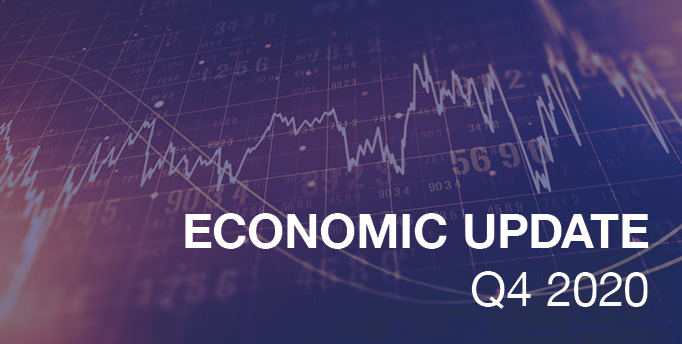The General Economy
In Q4 of 2020, the U.S. economy bore significant headwinds from COVID-19 but avoided a double-dip recession, largely thanks to residential housing activity. The breadth and depth of the pandemic’s surge, colder weather and the delay of a federal stimulus package hobbled economic activity as the quarter wore on. This was evident in worsening retail sales, declining consumer consumption and uneven industrial production. Improvement in unemployment stalled at 6.7 percent for both November and December. Despite these forces, the economy is expected to expand at an annual rate of approximately 5.3 percent, propelled by all things housing, from construction to “nesting” purchases. Residential investment dwarfed most drivers of growth, coming in at an exceptionally strong 28.1 percent annual rate. Hiring for big-box store retail, construction and warehousing were bright spots in otherwise disappointing employment numbers.
The Real Estate Market
Residential
It was a boom year and a good quarter for residential housing. Home sales are expected to total 6.7 million units in Q4 of 2020, a level last seen almost 15 years ago. The motivators are the same as in Q3 of 2020: near-record-low interest rates and demand for larger spaces to live, work and play. The 30-year fixed rate was 2.67 percent at the end of the year, a full percentage point lower than the end of 2019. Throughout the quarter, the Federal Reserve affirmed its commitment to short-term rates at or near zero and purchasing large numbers of mortgage-backed securities, thus greasing the wheels of the mortgage market. Mortgage credit availability was also beneficial to the home buyer, increasing both in October and November. A potential disruption to the lending markets was forestalled when the Federal Housing Administration announced it would extend its forbearance and foreclosure policies to February 28, 2021.
The record-setting market may have moderated this quarter, however. According to National Association of REALTORS® data, both existing and pending home sales dropped in November compared to October, down 2.5 percent and 2.6 percent, respectively. Lower consumer confidence from the slowing economic recovery and the late arrival of federal stimulus discouraged some buyers. Increasing price sensitivity also played a role. The U.S. Median House Price Index consistently rose over the last three quarters to 5.3 percent in Q4 of 2020, pushed by inventory at a historical low. Builders are responding as much as possible. Both housing permits and starts in November rose to levels last seen in 2007. As the Mortgage Bankers Association (MBA) stated in its November Housing Market Forecast Commentary, “To be clear, this pace is likely still insufficient given that we faced an inventory shortage even before the pandemic, but this increased production is certainly helping.”
This housing investment was one of the convergent forces shaping real estate in the suburbs and smaller metropolitan areas at the end of 2020. The residential migration to the suburbs and secondary cities is not a new phenomenon, but the pandemic has certainly amplified it.
Commercial
At the same time as home building moves out into new areas, industrial space wants to be nearer to those homes. Amazon alone is opening 1,500 smaller-format distribution centers for last-mile delivery. JLL reported in its U.S. Industrial Outlook for Q3 of 2020 that, year-to-date, e-commerce companies had leased 71.3 million square feet – a staggering 45.1 million square feet more than the prior year. Warehousing is having to get creative, taking over old candy factories and open mall space. Sparked by an explosion of home improvement and residential construction, leasing for construction materials and building fixtures was up by 42.3 percent. This competition for land may be elevating lease costs and deal prices. Industrial rents were up 4.2 percent annually in Q3 of 2020 and vacancy rates were close to record lows at 5.6 percent for the quarter. November data from Real Capital Analytics confirms that logistics sector appetite contributed to industrial deal price growth of 9.5 percent year over year.
One downside of the increasing proximity of new warehouses to neighborhoods is local pushback and issues related to sound ordinances, traffic restrictions and environmental laws. JLL predicts demand for an additional 1 billion square feet of industrial real estate by 2025, largely driven by e-commerce – meaning the impact of the convergent forces in the suburbs is just beginning.
A Glance Forward
Economists expect a very moderated start to the new year. While the eleventh-hour stimulus package will boost the economy, there is negative momentum from Q4 of 2020. Gross Domestic Product (GDP) is expected to grow by only 2.8 percent or 3 percent, according to Fannie Mae and the MBA, respectively. Both organizations see a slight improvement in unemployment to 6.4 percent. The intensity of the pandemic’s winter surge, the speed of the distribution of the vaccine and the Biden administration’s economic response to COVID-19 are all uncertainties impacting forecasts for Q1 of 2021.
After so much activity over the last two quarters, and facing limited inventory and builder capacity, residential investment is projected to expand a meager half a percent, according to the MBA. Consumers who played such a prominent role last summer won’t be out and about this plagued winter. But interest rates, expected to bottom out at 2.7 percent, will support robust mortgage originations and business investment in Q1 of 2021. The economy is projected to grow by 5.9 percent, with businesses benefiting from vaccinated people’s pent-up demand. So, while the worst of winter is coming, many are looking forward to the spring and summer.




